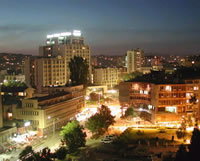
PristinaSince 1981, there has been no census in Kosovo. After the war, Pristina is overpopulated. Many figures, but based on the analysis and the number of voters, the number of people residing within the city, could be approximately 400 thousand, and 470 villages , is envisaged that the move to 500 thousand citizens . During all periods of history, the Balkans and Central East he was and continued to be the most dynamic areas of ethnic and social movements of the historical and political events. For this reason, the change occurred in ethnic and religious structure.
Because of this, mostly ethnic indigenous population suffered Illyrian, Thracian and Macedonian well. In the whirlwind of these events, there is also the space where today lies Pristina. Traces of residence in the capital of Kosovo, we find that the pre-ever support archeological locations found in the Early Neolithic, as Matican, Gracanica, etc. Ulpianë., Then in the Bronze Age, to the Ethno-culture Dardanian since centuries. VIII and VI before Crist.According to historical data written to c. XIV, for Pristina have little data and fragmentary. Thus, the structure of Pristina can not rely only on data from short narrative archive of Ragusa (today Dubrovnik), for the period paraosmane unused and Turkish documents consulted.
The first written Pristina is the year 1342 by the Byzantine Emperor, Johan Kantakuzen which describes Prishtina as a village. After this year, it is likely that there was St. Mary's Catholic Church and as priests mentioned the names, like the Albanians Don Lasio,existed during the old city of Ulpiana (Ulkiana), while during the early Middle Ages the city Zlatnic miners, then investigate that until the time of Ottoman rule, has not had a significant role in the century. XIV and XV when Pristina, capital of Kosovo today begins to develop as an important commercial center.CultureAs the capital of Kosovo is the center of cultural and artistic of all Albanians living in Kosovo. Directorate of Culture of the Municipality of Prishtina is a segment that cares only for important cultural events that Pristina today rank among the cities that has a tradition of emphasizing cultural and artistic. Library "Hivzi Sylejmani" established 60 years ago is now in its drawers over 70 thousand books in all languages of the world.
Only in Pristina, it also has four other branches located in most major neighborhoods of the city, so that the book is as close to the reader. There are also nine other branches of the library distributed in rural parts of the city and, in the village Bardhosh, Lugar, Keçekollë, Colic, Hajvali, Gracanica, Laplje Selo, Sushice of Čaglavica (the latter mostly populated by Serbs). Cultural heritage is a special chapter reflects the antiquity of Pristina as administrative and cultural center, Dardania from 3500 BC to the present day.In Pristina Museum found the statue of the Queen of Dardania. In the last fight, this statue by Serbian police and was taken to Belgrade, until this year, UN envoy in Kosovo, Michael Steiner turned it from Belgrade to Kosovo Museum in Bath Prishtinë.Në found Perishtinë City, Emin Gjika House, in which it is situated Academy of Sciences and Arts. Pristina has its archive, which was founded in the fifties of the last century and retains the entire archive fanaticism of the city and surrounding region Pristina.
From (34) tcultural and artistic societies that vivify the musical in Pristina, will separate association "Bajram Curri", founded in 1963, Song and Dance Ensemble of the University of Pristina was established in 1962, Choir "Colegium cantorum "established in 1963 and other cultural and artistic activities, which enrich the cultural life in the capital of Kosovës,event that is separate establishment of theater" Dodona "in 1986 and Kukullave.Dikur Theatre, Pristina had four cinema halls, while today there is only one and it operates within the company for the screening "Genc". Among the most important projects of the Youth Pristina remains with space of over 20,000 square meters.
In the center of Pristina is set Skanderbeg monument, Zahir Pajaziti and Mother Teresa.
Cafés & Nightlife in Pristina
Shkodra
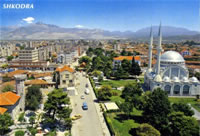 Shkodra has historically been one of the major Albanian cities. Greater development took in the nineteenth century. In 1870 it had about 50 000 inhabitants. Shkodra has historically been one of the major Albanian cities. Greater development took in the nineteenth century. In 1870 it had about 50 000 inhabitants. It became an important commercial hub for the Balkans, with 3,500 stores in the area now known as 'bazaar'.Since 1718, Shkodra had consular agencies in many foreign countries. As seen Oboti port, but especially Ulcinj and Shëngjin later. Over the years the League of Prizren (1878), Shkodra became an important center of the national movement. At
this time, a branch of Shkodra had her guard, which was helped by the
action and the protection of Plava, Guci, Hoti and Gruda, and the war in
Ulcinj.Shkodra is also a very important cultural center. Bushatllinj mention library and phototeque Marubi, which is known as the oldest in the Balkans and irreplaceable value. During the Balkan War and the First World War, Shkodra became prey to predatory aims of Montenegro and Serbia. Population
Shkodra defended the city for seven months against armies surrounding,
but on 23.04.1913, Serbo-Montenegrin army entered the city through the
betrayal of Esat Pasha Toptani.Serbo-Montenegrins were forced out after a few months and later spent Shkodra under international protection. The city of Tirana government passed in 1920.Shkodra can be mentioned as the center of Albanian Catholicism. Albania
was the last city that fell under Ottoman rule in 1479, and the city
that mostly opposed the advent of communism in 1944. Shkodra citizens were the first symbols of the dictatorship collapsed in 1989. It began the first spark nationwide protests against communism in late 1990.
Shkodra has historically been one of the major Albanian cities. Greater development took in the nineteenth century. In 1870 it had about 50 000 inhabitants. Shkodra has historically been one of the major Albanian cities. Greater development took in the nineteenth century. In 1870 it had about 50 000 inhabitants. It became an important commercial hub for the Balkans, with 3,500 stores in the area now known as 'bazaar'.Since 1718, Shkodra had consular agencies in many foreign countries. As seen Oboti port, but especially Ulcinj and Shëngjin later. Over the years the League of Prizren (1878), Shkodra became an important center of the national movement. At
this time, a branch of Shkodra had her guard, which was helped by the
action and the protection of Plava, Guci, Hoti and Gruda, and the war in
Ulcinj.Shkodra is also a very important cultural center. Bushatllinj mention library and phototeque Marubi, which is known as the oldest in the Balkans and irreplaceable value. During the Balkan War and the First World War, Shkodra became prey to predatory aims of Montenegro and Serbia. Population
Shkodra defended the city for seven months against armies surrounding,
but on 23.04.1913, Serbo-Montenegrin army entered the city through the
betrayal of Esat Pasha Toptani.Serbo-Montenegrins were forced out after a few months and later spent Shkodra under international protection. The city of Tirana government passed in 1920.Shkodra can be mentioned as the center of Albanian Catholicism. Albania
was the last city that fell under Ottoman rule in 1479, and the city
that mostly opposed the advent of communism in 1944. Shkodra citizens were the first symbols of the dictatorship collapsed in 1989. It began the first spark nationwide protests against communism in late 1990.Durres
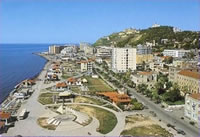 Durres is a coastal town in central Albania. Durres is the main port of the country, also an important port of the Mediterranean sea. The city has about 200,000 inhabitants and is the center of the prefecture and county of Durres.HistoryDurres can be compared with the greatest cities of the ancient Mediterranean and the Mediterranean. City
Epidamnos Dyrak Taulane was built by Illyrians, we dallendyshasit
XIII-XI centuries BC residents Dyrrachion first, before protoiler called
Illyrians, pelasgians raised in the suburbs of the town, the first
prehistoric settlements. In
terms of a Mediterranean climate, with the appropriate areas for
housing was one of the Erzeni (Ululeus) and its surrounding Western
Lowland. In the Gulf coast of Durres first moved center or harbor named Dyrrah. According to ancient authors, this city was founded by two kings called Illyrian origin and Epidamnos Dyrah.King
Epidamn built fortified part of the city in the southeast of Mount
Westmoreland, and his grandson Dyrrak, Port was built for many, many
centuries bears his name. From these two names survived until our days, Dyrrah-Durres name for himself in his role as Harbor-Port. The
true name of the local king Dyrrah, Peninsular indentifikohej and
configuration of relief, expressing the existence of two slopes (two
beat), which appear when entering the Gulf of Durres.The
city was rapidly developed to enable the replacement of Troies role,
becoming the appropriate liaison point between Europe and Hesperise
Pelegi-populated by Tusk of Dardanelle. X-VIII centuries BC Federation was created Taulane: Countries with Dyrrahu metropolis. VII-III
centuries BC Federation of shendrroi Taulane main Illyrian state
Taulanine in the Western Plain Panadriatike, making the capital Dyrrah,
all-city development "Dere window" of Europe. II
centuries BC until the new X wind, Western Europe known as Durres,
which was an independent state within the Roman-Byzantine Empire.
Durres is a coastal town in central Albania. Durres is the main port of the country, also an important port of the Mediterranean sea. The city has about 200,000 inhabitants and is the center of the prefecture and county of Durres.HistoryDurres can be compared with the greatest cities of the ancient Mediterranean and the Mediterranean. City
Epidamnos Dyrak Taulane was built by Illyrians, we dallendyshasit
XIII-XI centuries BC residents Dyrrachion first, before protoiler called
Illyrians, pelasgians raised in the suburbs of the town, the first
prehistoric settlements. In
terms of a Mediterranean climate, with the appropriate areas for
housing was one of the Erzeni (Ululeus) and its surrounding Western
Lowland. In the Gulf coast of Durres first moved center or harbor named Dyrrah. According to ancient authors, this city was founded by two kings called Illyrian origin and Epidamnos Dyrah.King
Epidamn built fortified part of the city in the southeast of Mount
Westmoreland, and his grandson Dyrrak, Port was built for many, many
centuries bears his name. From these two names survived until our days, Dyrrah-Durres name for himself in his role as Harbor-Port. The
true name of the local king Dyrrah, Peninsular indentifikohej and
configuration of relief, expressing the existence of two slopes (two
beat), which appear when entering the Gulf of Durres.The
city was rapidly developed to enable the replacement of Troies role,
becoming the appropriate liaison point between Europe and Hesperise
Pelegi-populated by Tusk of Dardanelle. X-VIII centuries BC Federation was created Taulane: Countries with Dyrrahu metropolis. VII-III
centuries BC Federation of shendrroi Taulane main Illyrian state
Taulanine in the Western Plain Panadriatike, making the capital Dyrrah,
all-city development "Dere window" of Europe. II
centuries BC until the new X wind, Western Europe known as Durres,
which was an independent state within the Roman-Byzantine Empire.
TiranaTo accompany you through Albania or to suggest an itinerary, it is natural to start this from the capital, Tirana. It is a difficult enterprise to involve the entire space of the Albanian capital with a single trip, but with a selection of the most beautiful countries, will leave the impression of këndshme.Le really start to travel through Albania Well, exploring before its capital Tirana.Meet TiranaTirana - Albania's capital today - was founded in 1614 by Sulejman Bargjini, a rich feudal times, the village Mullet. He first built a mosque and a bath, which then became the nucleus of the future city. It is thought that Tirana has been an inhabited, since at the time of the Illyrians, about the fourth century BC. The ruins of the city are still found today at the foot of Mount Dajti, which is thought to have been a castle. A source of Tirana name is exactly the name of the castle, Tirkan, which is mentioned for the first time in the history of the Byzantine historian Prokopius.In 1920, the Congress of Lushnja, Tirana was decided the temporary capital of Albania. Its final status received in 1925. Today, Tirana is a city that grows and changes daily and is the largest commercial and administrative in Albania. It is a city filled with hotels, restaurants, bars, pubs, center and entertainment complex, which allow you an active and diverse jet for all strata of the population and all the foreigners who visit Tirana because of the ndëryshmet . Tirana is also a center of national and international activities of either significant, seminars, symposia, conferences, festivals, shows, etc., that make a city already known and open to the world.If we had to do a complete list of attractions of the Albanian capital worth visiting, this list would be too long. From this list we detach you that you should never leave without seeing or visiting:The monument of national hero Gjergj Kastrioti Skanderbeg, in the center of Tirana, a number of historic buildings, Ethem Bey Mosque, Clock Tower, 35 m high, built in 1830. From the top of the tower, which is open to visitors, can be enjoyed a fantastic view of Skanderbeg Square.Tabakve Bridge, (XVIII), a fragment of the castle of Justinian, Near Cinema Millennium 2. Mother Albania monument in Martyrs Cemetery, located in the southeastern part of kryeqytetit.Teatrin of Opera and Ballet, the National Theatre, Gallery of Fine Art, International Center of Culture, the Palace of Congresses, History Museum, Archaeological Museum, Museum of Science Nature, etc..The park lies in the southern part of the Great Lake, with a surface of 230 ha site and artificial lake in the middle of it with a surface of 55 ha site. In the Great Forest Park, 120 species grow pemsh and decorative plants and a large number of flowers. Not far from town, you can practice mountain tourism. 25 km from Tirana, rises Mount Dajtit which can be passed very beautiful holiday, filled with activities such as trekking, excursions, skiing, etc.. Now you can use the funicular transportation, which traverses the space of 15 minutes and gives you the opportunity to enjoy the magnificent view of nature from above. This reduces the time and creates many more opportunities for tourism favorite daily offering of mountain areas Dajtit. Dajtit National Park, a growing number of plants and animals is strictly prohibited and hunting out of season.Another possibility is the best outside Tirana with Hole Mountain, where people can go to relax, away from the noise of the metropolis. 15 km south of Tirana, located Petrelë Castle, with a two thousand vjeare age, built by Illyrian tribes Albans, with Glaukun Leader. The castle rises on top of a hill, offering an amazing panorama of the whole area. At the time of Skanderbeg, the castle is commanded by Mamica Princess, sister of George Castriota and was part of the Principality of Kruja.15 km northwest of Tirana, located fortress of Preza, this part of the Principality of Kruja. Situated near the Rinas Airport, the castle is a place frequented by many tourists for offering unique views.Another interesting place is Pëllumbas, or "Black Cave", discovered only recently, 18 km from Tirana, Skoranës area. With interior walls coated with stalactites and stalagmites, it is not only an attractive place for visitors but also for researchers and Speleologists.Music of all types for a fun nightIn Tirana will find dozens of local and nightclubs of different genders, where you can go to enjoy the music that you plqen. Jazz clubs, pubs, discos, cabarets, bistro, oriental environments, live music, without leaving aside the many concerts and activities that played in theaters, halls and cultural centers. In this long list would you suggest some of them, where the activity is undoubtedly permanent and guaranteed satisfaction. So for the best dance music of the moment, you can go to Folie Club, to enjoy cabaret and spectacle, suggest Magic 4 Karaoke, listen to live Pere known singers, do well to visit Venue Club for an evening of comfortably in the company of friends and best music 60-70-80 years, should go to Charles Bistro or Living Room and many other countries. Certainly not lacking in any entertainment of the night but countries is an alternate choice
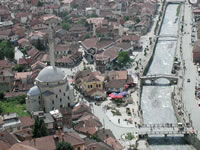
PrizrenThe city of Prizren lies in the southern part of Metohija plane, the first road linking the northern coast of Albanian lands and its civic centers, commercial interior regions of Kosovo and the Balkans. Archeological findings prove the existence of an active life in the territory of Prizren today since ancient times beyond, where it was known by the name of theranda lived in this area a pure population of Illyrian, Dardanians.In the eleventh century, is known as an important urban center. In 1019 mentioned as headquarters of the Byzantine Empire Church. During Serbian rule (XII-XIV century) settled in these regions Slavic population. In the reign of King Dushan and Uros, Prizren that occasionally the seat of their kingdoms.After the invasion of the Ottoman Empire (1455), although temporarily lost its significance, became a powerful economic, cultural and administrative (center Sandzak and Vilayet). In the nineteenth century Prizren was the second most important economic and trade Albanian territories with approximately 1,500 stores at the end of this period. As after 1874's annual Turkish city of Prizren had 44,000 inhabitants of whom about 35,000 Albanian.Prizren holds a special place in the history of the Albanian National Movement, became the capital of the League of Prizren, which was founded on 10 June 1878. In Prizren had its headquarters the Provisional Government of Albania (1881), led by well-known resident of this city, Ymer Prizren.In 1913, Serbian-Montenegrin government decided where a large number of Albanian families were evacuated from the city in Turkey. During World War II and its people of his district includes the Antifascist Movement Nadonalçlirimtare. Prizren was released on November 17, 1944.After the war, until 1947, was the center of Prizren Kosovo Autonomous County. However there was no significant development. Even then it was one of the most outstanding centers throughout Jugosllavinë.Në late 50's to mid 60's from Prizren over 3,200 families fled to Turkey.From sensational historical past, Prizren has inherited a large number of cultural and historical values. The most important are: Shatirvanit Complex, Nënkalaja, Marash, Castle, Church of St. Ljeviška, Church of St. Saviour, Bajraklisë Mosque, Safi Sinan Pasha Mosque, hammams city, the city's water sources, stone bridge and a number of big houses, inherited folklore for centuries.
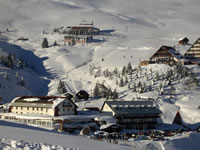
Tetovo
Tetovo is located in the northwestern part of Macedonia. It is bordered by Kosovo north, east of Skopje, at Makedonski Brod south and southwest and west of Gostivar. Tetovo with area of 1080 km2 lies at the bottom of the Pollog area and is surrounded by Sharr Mountain and Dry Mountain, with an altitude of 460-500 m. Moderate continental climate with an annual average temperature of about 11.6O °.
In Tetovo live near 200,000 inhabitants, of whom about 80.3% Albanian, Slav-Macedonians 14.7% and 5% other, located in 92 settlements. Tetovo was the center of economic, cultural and administrative mentioned in ancient times where named Aeneas. In 2005 the share MUNICIPALITY Tetovo are also nine other municipalities, which receive development as a center of Tetovo.
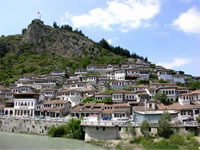
Berat
Berat is one of the most important Albanian cities in terms of history and architecture. Before the foundation of the city dates back about fourth-century BC. Then desaretëve part of the province and one of the most important Illyrian city spent some hard times during the war Illyrian-Roman-Macedonian and Roman. In 216 BC he named Antipatrea Polibio. Around the year 200 AD the city was taken by the Romans. The Middle Ages were dark Berat. In the 860-927 first look Bulgarian invasion. During the invasion of the second Bulgarian city is named Belgrade which means white city. After the fall of the Byzantine Empire, Berat become an important center of the Diocese of Epirus. In 1417 the town was captured by the Ottoman Empire during this period also create Patriarchy of Portland.
In November 1670, the Turkish traveler, Evliya Çelebi, went his way in southern Albania. After visiting Ergiri (Gjirokastra), he traveled to Tepelenë twice in one day was ambushed by rebels from Progonati. After Tepelenë, he arrives in the city of Portland, which he calls the praise of Jihad stately province. Berat described by Evlijai seems a city with a highly developed and with an amazing civilization.
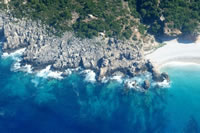
Saranda
Saranda is a city located in southern Albania's Ionian coast opposite the famous Greek island of Corfu. It is situated on a mountain slope.
story
For the first time the name is mentioned in Saranda ... Saranda is a city in southern Albania, located in the Ionian coast, opposite the island of Corfu. Saranda name comes from an early Christian monastery dedicated to the Forty Saints (Ágii Saranda in Greek) (Santi Quaranta in Italian).
Transportation
Saranda is situated about 300 km from Tirana, Albania's capital. Temporarily only means of travel to Saranda are vehicles. Sarnadës maritime transport links to the city only Greek city of Corfu and Igoumenitsa. It is designed to build on the city's airport Vrion village, 1 km away from him.
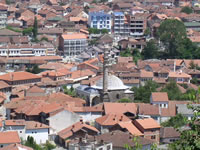
Gjakova
According to archaeological data made by joint teams from Albania and Kosovo, in the territory of Djakovica, based on materials found is proved to belong to the ancient culture has been proved and proved that these lands have been inhabited even earlier.
Gjakova city of this name dates from the fifteenth century, but its true flowering begins in the late sixteenth and early seventeenth century. From this period mention Hadum mosque building in vitin1554, maytap, Library, Haram, Hammam-building get the Clock Tower, the Great Madrasah, Hani old Great Tekke Complex and bridges connecting the city on the river Krena, as she Tabakut, Talic etj.të bridge which exist today. Gjakova municipality today has 586 square kilometers which make up the city and 84 villages. According to the last census conducted in 2000 by UNMIK, Djakovica municipality has 150,800 inhabitants, ranking as the third largest municipality in Kosovo size.
Gjakova municipality has good connections with paved roads with towns of Prizren, Pec, Orahovac, Kline, Pristina, Decani, etc. Malisheve. W t is important to note that the Gjakova municipality after the 1999 war has links with the Republic of Albania, through two border crossings that the Prushit neck and neck at the Morina.
